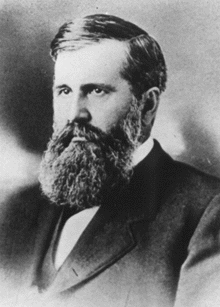Samuel Hitt Elbert
| Samuel Hitt Elbert | |
|---|---|
 | |
| 6th Governor of the Territory of Colorado | |
|
In office 1873–1874 | |
| Preceded by | Edward M. McCook |
| Succeeded by | Edward M. McCook |
| Personal details | |
| Born |
April 3, 1833 Logan County, Ohio |
| Died |
November 27, 1899 (aged 66) Galveston, Texas |
| Political party | Republican Party |
Samuel Hitt Elbert (April 3, 1833 – November 27, 1899) served as Governor of the Territory of Colorado (1873–1874) and Chief Justice of the Supreme Court of the State of Colorado (1879–1883).
Samuel Hitt Elbert was born in Logan County, Ohio. At age seven, he moved with his family to the Territory of Iowa, where he attended public school and studied agriculture. He graduated from Ohio Wesleyan University with high honors in 1854 and moved to the Territory of Nebraska to practice law. In Nebraska, Elbert became active in the newly formed Republican Party. Elbert was appointed Secretary of the Territory of Colorado and served from 1862 until 1867. Secretary Elbert organized the Republican Party in the Colorado Territory. Samuel Elbert married Josephine Evans, the daughter of his mentor, Territorial Governor John Evans.
U.S. President Ulysses S. Grant appointed Samuel Elbert as the sixth Governor of the Territory of Colorado on April 4, 1873. President Grant became the first U.S. President to visit the Rocky Mountain region that summer. The President stayed at Governor Elbert's home, visited Central City, and met with a group of Ute leaders. Governor Elbert served until June 19, 1874, when his predecessor, Edward Moody McCook, was reappointed Governor. Samuel Elbert was appointed to the Supreme Court of the State of Colorado in 1877 where he served until 1889. Elbert served as the Chief Justice of the Supreme Court from 1879 to 1883. Samuel Elbert died on November 27, 1899.
Elbert County, Colorado; Elbert, Colorado; and Mount Elbert, the highest peak in the Rocky Mountains, are named in honor of Samuel Hitt Elbert.[1] Grateful miners named Mount Elbert after the governor because he brokered a treaty with the Ute tribe, which opened up more than 3,000,000 acres (12,000 km2) of Indian reservation to mining and railroad activity.
See also
- Colorado Supreme Court
- History of Colorado
- Law and Government of Colorado
- List of Governors of Colorado
- State of Colorado
- Territory of Colorado
References
- ↑ Gannett, Henry (1905). The Origin of Certain Place Names in the United States. Govt. Print. Off. p. 116.
External links
- Official biography of Samuel Hitt Elbert
- Justice Samuel Hitt Elbert
- Samuel Hitt Elbert at Find a Grave
